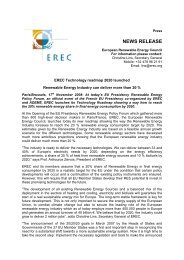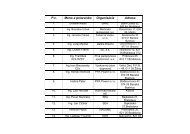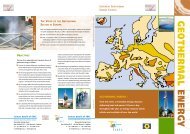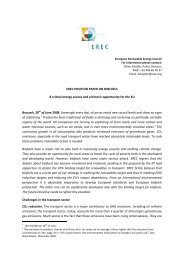EREC's position on the future of RES Electricity support mechanisms
EREC's position on the future of RES Electricity support mechanisms
EREC's position on the future of RES Electricity support mechanisms
You also want an ePaper? Increase the reach of your titles
YUMPU automatically turns print PDFs into web optimized ePapers that Google loves.
European Renewable Energy Council
Executive SummaryFuture <strong>RES</strong>-E <strong>support</strong> <strong>mechanisms</strong>EREC’s Positi<strong>on</strong> Paper <strong>on</strong> <strong>the</strong> <strong>future</strong> <strong>of</strong><strong>support</strong> systems for <strong>the</strong> promoti<strong>on</strong> <strong>of</strong>electricity from renewable energy sourcesEREC and its members, <strong>the</strong> European renewable energyindustry, trade and research associati<strong>on</strong>sAEBIOM (European Biomass Associati<strong>on</strong>),EGEC (European Geo<strong>the</strong>rmal Energy Council),EPIA (European Photovoltaic Industry Associati<strong>on</strong>),ESHA (European Small Hydropower Associati<strong>on</strong>),ESTIF (European Solar Thermal Industry Federati<strong>on</strong>),EUBIA (European Biomass Industry Associati<strong>on</strong>),EUREC Agency (European RenewableEnergy Centres Agency) andEWEA (European Wind Energy Associati<strong>on</strong>)representing a European industry sector with an annualturnover <strong>of</strong> more than € 15 billi<strong>on</strong>, c<strong>on</strong>sider that <strong>the</strong>Directive <strong>on</strong> <strong>the</strong> promoti<strong>on</strong> <strong>of</strong> electricity from renewableenergy sources, adopted in 2001, will be subject toevaluati<strong>on</strong> and to possible amendments by <strong>the</strong> Europeaninstituti<strong>on</strong>s in 2005 and <strong>the</strong>refore present <strong>the</strong>ir opini<strong>on</strong>to this important debate.As part <strong>of</strong> <strong>the</strong> debate where <strong>the</strong> Commissi<strong>on</strong> may presenta report at <strong>the</strong> latest by 27 th October 2005, EREC providesits analysis and comes to <strong>the</strong> following c<strong>on</strong>clusi<strong>on</strong>s:Effective competiti<strong>on</strong> in <strong>the</strong> c<strong>on</strong>venti<strong>on</strong>alpower market is a prec<strong>on</strong>diti<strong>on</strong> forharm<strong>on</strong>ising <strong>support</strong> <strong>mechanisms</strong> forpower from renewable energy sources:EREC welcomes <strong>the</strong> idea <strong>of</strong> harm<strong>on</strong>ising <strong>support</strong><strong>mechanisms</strong> to avoid fur<strong>the</strong>r market distorti<strong>on</strong>sin <strong>the</strong> European power market. But such harm<strong>on</strong>isati<strong>on</strong>must be well prepared to avoid disturbingexisting markets. The first step towards harm<strong>on</strong>isati<strong>on</strong>for renewables electricity must be a wellfuncti<strong>on</strong>ing,undistorted Internal <strong>Electricity</strong> Marketand a truly level playing field.95% <strong>of</strong> <strong>the</strong> European Internal <strong>Electricity</strong> Market isbased <strong>on</strong> c<strong>on</strong>venti<strong>on</strong>al power sources and 5% isbased <strong>on</strong> renewables (without large hydro). Thereare numerous distorti<strong>on</strong>s in <strong>the</strong> 95% c<strong>on</strong>venti<strong>on</strong>alelectricity market, and competiti<strong>on</strong> is far from beingeffective.Too early to harm<strong>on</strong>ise <strong>support</strong><strong>mechanisms</strong> for renewable electricityA harm<strong>on</strong>ised Community-wide <strong>support</strong> mechanismfor renewables at this early stage would bepremature, since <strong>the</strong>re is not yet enough experienceas to which system would be <strong>the</strong> most effective<strong>on</strong> <strong>the</strong> EU level to guarantee market development<strong>of</strong> all <strong>the</strong> renewable power technologies.There is no practical evidence yet <strong>of</strong> effectivenessbey<strong>on</strong>d feed-in and fixed-premium systems. Quotabased <strong>mechanisms</strong> have not yet proven <strong>the</strong>ir abilityto provide investor security, attract investment andprovide c<strong>on</strong>siderable deployment. These must begiven time to develop fur<strong>the</strong>r in order to providereal experience ra<strong>the</strong>r than <strong>the</strong>oretical hypo<strong>the</strong>sis.2Photo credits: ÖkoFen, BP Solar, Oliver Joswig, Österreichischer Verein für Kleinkraftwerke, EHN,O.Ö. Energiesparverband, GE Energy
Any nati<strong>on</strong>al <strong>support</strong> mechanism should guaranteean adequate return <strong>on</strong> investment toensure attractiveness <strong>of</strong> investments adaptedto <strong>the</strong> level <strong>of</strong> costs <strong>of</strong> all <strong>RES</strong>-E technologies.Setting mandatory <strong>RES</strong>-E targets:Setting <strong>of</strong> mandatory nati<strong>on</strong>al targets for2010 would be appropriate and lead to moreefforts in all Member States.Removal <strong>of</strong> administrative barriers:Administrative barriers in <strong>the</strong> Member Statesshould be removed more effectively, both, byimposing str<strong>on</strong>ger regulati<strong>on</strong> <strong>on</strong> <strong>the</strong> EU leveland by better applicati<strong>on</strong> <strong>of</strong> <strong>the</strong> already existinglegislati<strong>on</strong> at <strong>the</strong> nati<strong>on</strong>al level.Give priority grid access torenewable energies:New ambitious, mandatory, nati<strong>on</strong>al targetsfor 2020 would show <strong>the</strong> EU´s commitmentand would significantly enhance investor c<strong>on</strong>fidence.2020 targets would also dramaticallyincrease <strong>the</strong> Community’s chance <strong>of</strong> meeting<strong>the</strong> existing 2010 targets.The rules <strong>on</strong> grid access for and transmissi<strong>on</strong><strong>of</strong> renewables electricity should be fur<strong>the</strong>rharm<strong>on</strong>ised and streng<strong>the</strong>ned in favour <strong>of</strong>renewable energy technologies. Member Statetrans<str<strong>on</strong>g>positi<strong>on</strong></str<strong>on</strong>g> <strong>of</strong> existing legislati<strong>on</strong> <strong>on</strong> gridaccess must be ensured.Reaching technological diversity within <strong>the</strong>renewable energy sector is crucial and <strong>the</strong>aim <strong>of</strong> any <strong>support</strong> mechanism should be toencourage and streng<strong>the</strong>n this diversity.Indicative targets for <strong>the</strong> share <strong>of</strong> <strong>the</strong> differentrenewable energy technologies in 2020should be set at <strong>the</strong> overall EU level in a processsimilar to <strong>the</strong> <strong>on</strong>e that established <strong>the</strong>overall EU 2010 White Paper targets. Thatwould streng<strong>the</strong>n <strong>the</strong> aim <strong>of</strong> reaching technologicaldiversity in <strong>the</strong> renewable energysector and enable each <strong>of</strong> <strong>the</strong> different technologiesto realise its competitive potential.Recommendati<strong>on</strong>s from <strong>the</strong> Commissi<strong>on</strong>should be made for nati<strong>on</strong>al promoti<strong>on</strong> <strong>mechanisms</strong>,that include l<strong>on</strong>g-term stability,technological diversity and effectiveness inreaching <strong>the</strong> nati<strong>on</strong>al mandatory targets.Ensure technological diversityand raise public awareness:A broad diversificati<strong>on</strong> and <strong>support</strong> <strong>of</strong> allexisting <strong>RES</strong>-E technologies is crucial for <strong>the</strong>fur<strong>the</strong>r development <strong>of</strong> a truly sustainableenergy system.A greater focus at <strong>the</strong> European, nati<strong>on</strong>aland regi<strong>on</strong>al level should be placed <strong>on</strong> raisingpublic awareness <strong>of</strong> <strong>the</strong> benefits <strong>of</strong> renewableenergy technologies.Future <strong>RES</strong>-E<strong>support</strong><strong>mechanisms</strong>3
EREC’s recommendati<strong>on</strong>sFuture <strong>RES</strong>-E <strong>support</strong> <strong>mechanisms</strong>BackgroundDuring <strong>the</strong> White Paper discussi<strong>on</strong>s, <strong>the</strong> European Parliamentcalled for a European-wide harm<strong>on</strong>ised system for<strong>the</strong> promoti<strong>on</strong> <strong>of</strong> electricity from renewables, based <strong>on</strong>a feed-in system. But <strong>the</strong> most successful model in terms<strong>of</strong> market penetrati<strong>on</strong> and growth rates for renewables,<strong>the</strong> feed-in system with fixed prices, did not have a majorityin <strong>the</strong> Council at that time, and <strong>the</strong> European Parliamentwithdrew its demand. It must be recognised that due to<strong>the</strong> current political reality it is doubtful whe<strong>the</strong>r such asystem could be introduced in an effective way at <strong>the</strong>European level at this stage in time.Effective competiti<strong>on</strong> in <strong>the</strong> c<strong>on</strong>venti<strong>on</strong>alpower market is a prec<strong>on</strong>diti<strong>on</strong> for harm<strong>on</strong>ising<strong>support</strong> <strong>mechanisms</strong> for power from <strong>RES</strong>EREC welcomes <strong>the</strong> idea <strong>of</strong> harm<strong>on</strong>ising <strong>support</strong> <strong>mechanisms</strong>to avoid fur<strong>the</strong>r market distorti<strong>on</strong>s in <strong>the</strong> Europeanpower market. But such harm<strong>on</strong>isati<strong>on</strong> must bewell prepared to avoid disturbing existing markets. Thefirst step towards harm<strong>on</strong>isati<strong>on</strong> for renewables must be awell-functi<strong>on</strong>ing, undistorted Internal <strong>Electricity</strong> Marketand a true level playing field.95% <strong>of</strong> <strong>the</strong> European power supply is based <strong>on</strong> c<strong>on</strong>venti<strong>on</strong>alpower sources, including large hydro, and 5% isbased <strong>on</strong> renewables (without large hydro). There arenumerous distorti<strong>on</strong>s in <strong>the</strong> 95% c<strong>on</strong>venti<strong>on</strong>al electricitymarket, and competiti<strong>on</strong> is far from being effective.While some stakeholders in <strong>the</strong> c<strong>on</strong>venti<strong>on</strong>al Europeanpower sector ask for competiti<strong>on</strong> am<strong>on</strong>gst renewablepower producers, it should be recalled that effectivecompetiti<strong>on</strong> in more than 95% <strong>of</strong> <strong>the</strong> market that isbased <strong>on</strong> c<strong>on</strong>venti<strong>on</strong>al electricity is a far cry from realityas pointed out in <strong>the</strong> European Commissi<strong>on</strong>´s four benchmarkingreports <strong>on</strong> <strong>the</strong> Internal <strong>Electricity</strong> Market.It seems premature to call for competiti<strong>on</strong> in <strong>the</strong> renewablespower segment at a time <strong>of</strong> n<strong>on</strong>-competiti<strong>on</strong> inc<strong>on</strong>venti<strong>on</strong>al power. Renewable energy technologiescould already be competitive if <strong>the</strong>y had received <strong>the</strong>same attenti<strong>on</strong> in terms <strong>of</strong> R&D funding, subsidies, andif external costs were reflected in power prices. Removingsubsidies to fossil fuels and nuclear power and applying<strong>the</strong> ‘polluter pays’ principle - established in Article 174 <strong>of</strong><strong>the</strong> Treaty - to <strong>the</strong> electricity market, would go a l<strong>on</strong>gway to level <strong>the</strong> current n<strong>on</strong>-level playing field andreduce <strong>the</strong> need for renewables <strong>support</strong> drastically.As l<strong>on</strong>g as no true internalisati<strong>on</strong> <strong>of</strong> external costs via afair taxati<strong>on</strong> mechanism is introduced in Europe, <strong>the</strong>rewill be no level-playing field. And as l<strong>on</strong>g as this is nothappening, <strong>support</strong> <strong>mechanisms</strong> for renewable energypower are not <strong>on</strong>ly necessary, but also have to be judgedas fair and compensati<strong>on</strong>al for <strong>the</strong> avoided externalcosts and subsidies and o<strong>the</strong>r <strong>support</strong> given to c<strong>on</strong>venti<strong>on</strong>alenergy.Too early to harm<strong>on</strong>ise <strong>support</strong><strong>mechanisms</strong> for renewables electricityUnless <strong>the</strong> numerous current distorti<strong>on</strong>s in <strong>the</strong> emergingInternal <strong>Electricity</strong> Market are overcome, <strong>the</strong>re will be noeffective Internal Renewable <strong>Electricity</strong> Market for renewablesto compete in given <strong>the</strong> many interacti<strong>on</strong>s between<strong>the</strong> c<strong>on</strong>venti<strong>on</strong>al power markets and renewable electricitymarkets.A harm<strong>on</strong>ised Community-wide <strong>support</strong> mechanism forrenewables at this early stage would be premature, since<strong>the</strong>re is not yet enough experience as to which systemwould be <strong>the</strong> most effective <strong>on</strong> <strong>the</strong> EU level to guaranteemarket development <strong>of</strong> all <strong>the</strong> renewable energytechnologies.4
As a result <strong>of</strong> <strong>the</strong> adopti<strong>on</strong> <strong>of</strong> <strong>the</strong> <strong>RES</strong>-E Directivein 2001, several nati<strong>on</strong>al <strong>support</strong> <strong>mechanisms</strong>have been introduced during <strong>the</strong> past years andmany are still in <strong>the</strong> implementati<strong>on</strong> stage. S<strong>of</strong>ar experience clearly shows that <strong>on</strong>ly feed-insystems and fixed-premium <strong>mechanisms</strong> haveproven <strong>the</strong>ir ability to be effective in attractinginvestments, creating investor c<strong>on</strong>fidence, reaching<strong>the</strong> nati<strong>on</strong>al targets and creating a technologicaldiversity.Introducing any harm<strong>on</strong>ised, Community-widesystem at this stage would lead to serious marketinstability and threaten <strong>the</strong> technological developmentas well as <strong>the</strong> world’s largest marketsfor renewable electricity technology. An initiati<strong>on</strong><strong>of</strong> discussi<strong>on</strong> <strong>on</strong> how c<strong>on</strong>cretely sucha system could be designed and adapted at<strong>the</strong> European level al<strong>on</strong>e could lead to seriousinvestor insecurity, threaten Europe’s global leadership<str<strong>on</strong>g>positi<strong>on</strong></str<strong>on</strong>g> in renewable energy technologyand undermine developing and already functi<strong>on</strong>ingnati<strong>on</strong>al markets.Harm<strong>on</strong>ising <strong>support</strong> systems now would seriouslythreaten <strong>the</strong> development <strong>of</strong> <strong>the</strong> Europeanrenewable electricity industry, especiallyif an untested mechanism is pursued. It shouldalso be stressed that even systems that haveproven successful at nati<strong>on</strong>al level are not easilyadapted to multilateral cross-border trade. Fur<strong>the</strong>rmore,many examples have shown that evensmall adjustments to a framework can have apr<strong>of</strong>ound negative effect <strong>on</strong> <strong>the</strong> markets forrenewables. More fundamental changes willhave an even greater effect <strong>on</strong> <strong>the</strong> markets. Adramatic shift in all Member States’ frameworkswould jeopardise nati<strong>on</strong>al renewable targetsand undermine investor c<strong>on</strong>fidence.C<strong>on</strong>sequently EREC proposes to improve <strong>the</strong>European framework and to prepare for a Community-widemechanism without harm<strong>on</strong>ising<strong>the</strong> <strong>support</strong> mechanism at this stage. At a laterstage, when more experience has been gainedwith <strong>the</strong> full range <strong>of</strong> policy opti<strong>on</strong>s and when<strong>the</strong> serious market distorti<strong>on</strong>s in <strong>the</strong> c<strong>on</strong>venti<strong>on</strong>alpower markets have been overcome, harm<strong>on</strong>isati<strong>on</strong>might be c<strong>on</strong>sidered.At this stage it seems clear that it is too early tointroduce a harm<strong>on</strong>ised <strong>support</strong> mechanismfor renewable electricity. Instead <strong>the</strong> EU shouldintroduce detailed recommendati<strong>on</strong>s for <strong>the</strong>Member States and improve its legislati<strong>on</strong> <strong>on</strong><strong>the</strong> European level where necessary. Such recommendati<strong>on</strong>swould limit <strong>the</strong> variety <strong>of</strong> systemsand could lead to bilateral cross-borderagreements between Member States havingsimilar systems. With a pro<strong>of</strong> <strong>of</strong> being successful,certain Member States with <strong>the</strong> same design <strong>of</strong><strong>support</strong> <strong>mechanisms</strong> could start clustering <strong>the</strong>irsystems and by that seek to create and testcross-border <strong>mechanisms</strong>. In this way more experiencewould be gained about <strong>the</strong> full palette<strong>of</strong> opti<strong>on</strong>s and a decisi<strong>on</strong> <strong>on</strong> <strong>future</strong> harm<strong>on</strong>isati<strong>on</strong>can be based <strong>on</strong> more evident knowledge.Future <strong>RES</strong>-E<strong>support</strong><strong>mechanisms</strong>5
Future <strong>RES</strong>-E <strong>support</strong> <strong>mechanisms</strong>Finally, it must be stressed that successful frameworksrequire not just a good payment mechanism and <strong>the</strong>encouragement <strong>of</strong> public <strong>support</strong>, but also effective policiesto remove <strong>the</strong> numerous barriers to grid access andtransmissi<strong>on</strong> and barriers in <strong>the</strong> form <strong>of</strong> administrativeprocedures and n<strong>on</strong>-transparency.Setting mandatory <strong>RES</strong>-E targetsTo ensure investor c<strong>on</strong>fidence it is important that <strong>the</strong>investor can rely <strong>on</strong> <strong>the</strong> l<strong>on</strong>g-term stability <strong>of</strong> any existing<strong>support</strong> mechanism. It is sec<strong>on</strong>dary which system exists.Creating stop-and-go markets by changing <strong>the</strong> level andnature <strong>of</strong> <strong>support</strong> frequently must be avoided. The EUshould ensure that a minimum <strong>of</strong> 10 years be guaranteedfor any nati<strong>on</strong>al <strong>support</strong> mechanism in <strong>the</strong> MemberStates. A first step to reach l<strong>on</strong>g-term stability and createinvestor c<strong>on</strong>fidence would be to change <strong>the</strong> existingindicative targets into mandatory targets for 2010. Theearly setting <strong>of</strong> new mandatory targets for <strong>the</strong> period after2010 would reduce uncertainty am<strong>on</strong>g investors and <strong>of</strong>ferstable market c<strong>on</strong>diti<strong>on</strong>s. The EU should set new bindingtargets for 2020 that aim at reaching at least a 33% share<strong>of</strong> renewables electricity by 2020 and brake this down int<strong>on</strong>ati<strong>on</strong>al mandatory targets, in a process similar to <strong>the</strong> <strong>on</strong>ethat established <strong>the</strong> overall EU 2010 White Paper targets.The experiences at <strong>the</strong> nati<strong>on</strong>al level show that, if <strong>the</strong>appropriate <strong>support</strong> mechanism has been chosen, it ispossible to reach <strong>the</strong> given nati<strong>on</strong>al targets. Any systemto be adopted at <strong>the</strong> nati<strong>on</strong>al level should be focussed<strong>on</strong> being effective in meeting <strong>the</strong> targets.Removal <strong>of</strong> administrative barriersseem to be ei<strong>the</strong>r too weak or not properly transposedinto nati<strong>on</strong>al law. These rules should be streng<strong>the</strong>ned infavour <strong>of</strong> renewables. A clear timetable for approving <strong>RES</strong>projects should be set for all administrati<strong>on</strong>s <strong>on</strong> all levels.Priority to <strong>RES</strong> projects should be given.The Commissi<strong>on</strong> should propose more detailed proceduralguidelines to streng<strong>the</strong>n <strong>the</strong> existing legislati<strong>on</strong> <strong>on</strong> <strong>the</strong>EU level, and at <strong>the</strong> same time to encourage <strong>the</strong> effortsat <strong>the</strong> nati<strong>on</strong>al level to implement current EU legislati<strong>on</strong>.Give grid access priority to renewablesRules <strong>on</strong> grid access, transmissi<strong>on</strong> and cost sharing arenot sufficient at <strong>the</strong> European level. Article 7 <strong>of</strong> Directive2001/77 (Directive <strong>of</strong> <strong>the</strong> European Parliament and <strong>of</strong><strong>the</strong> Council <strong>on</strong> <strong>the</strong> promoti<strong>on</strong> <strong>of</strong> electricity from <strong>RES</strong>)is not clear enough <strong>on</strong> all aspects, especially c<strong>on</strong>cerningcost distributi<strong>on</strong> and transmissi<strong>on</strong> fees. As already demandedby <strong>the</strong> European Parliament during <strong>the</strong> negotiati<strong>on</strong>s<strong>of</strong> <strong>the</strong> Directive, <strong>the</strong>se rules should be set outmuch more favourably for renewables and <strong>the</strong> implementati<strong>on</strong><strong>of</strong> <strong>the</strong> EU rules into nati<strong>on</strong>al law should bec<strong>on</strong>trolled and enforced more strictly by <strong>the</strong> Commissi<strong>on</strong>.Where necessary, grid extensi<strong>on</strong> or reinforcement costsshould be born by <strong>the</strong> grid operators and shared betweenall c<strong>on</strong>sumers, because <strong>the</strong> envir<strong>on</strong>mental benefits <strong>of</strong>renewables are a public good and systems operati<strong>on</strong> isa natural m<strong>on</strong>opoly. Strict legal and ownership unbundlingand str<strong>on</strong>g regulati<strong>on</strong> should be implemented in this field.Ensure technological diversityand raise public awarenessComplex licensing procedures for renewable projectsc<strong>on</strong>stitute <strong>on</strong>e <strong>of</strong> <strong>the</strong> most difficult obstacles renewablesprojects have to face. The existing European rules (Art. 6)For <strong>the</strong> benefit <strong>of</strong> encouraging technological diversityam<strong>on</strong>gst <strong>the</strong> different renewable energy technologies,<strong>the</strong> EU should set overall indicative targets at <strong>the</strong> EU level6
for <strong>the</strong> different renewable energy technologiessimilar to <strong>the</strong> process pursued with <strong>the</strong> existingWhite Paper targets. In return not <strong>on</strong>ly <strong>the</strong> mostmature and cheapest available technologies willdevelop, but also less developed <strong>on</strong>es.Any <strong>support</strong> mechanism at <strong>the</strong> nati<strong>on</strong>al levelshould take into account <strong>the</strong> diversity <strong>of</strong> renewableenergy technologies. All Member Statesshould be encouraged to <strong>support</strong> a wide range<strong>of</strong> renewable energy technologies with respect togeographical possibilities and variati<strong>on</strong>s <strong>of</strong> scale.Different renewable energy technologies workin different market segments and may require differentapproaches in order to reach <strong>the</strong>ir competitivepotential as so<strong>on</strong> as possible.Encouraging Local and Regi<strong>on</strong>alBenefits and Public AcceptanceThe development <strong>of</strong> renewable energy technologiescan have a significant impact <strong>on</strong> local andregi<strong>on</strong>al areas, both due to installati<strong>on</strong> and manufacturing.Some <strong>support</strong> schemes include publicinvolvements that hinder or facilitate <strong>the</strong> acceptance<strong>of</strong> renewable energy technologies. A<strong>support</strong> scheme’s ability to encourage local/regi<strong>on</strong>al development, employment and incomegenerati<strong>on</strong> should be investigated. It shouldalso be assessed whe<strong>the</strong>r a certain <strong>support</strong>scheme is able to sustain public acceptance <strong>of</strong>renewables or not, including positive impactor increased stakeholder involvement.In <strong>the</strong> l<strong>on</strong>g run, a truly sustainable energy systemwill have to be based <strong>on</strong> a mixture <strong>of</strong> renewableenergy technologies, each with differentstrengths and abilities to complement eacho<strong>the</strong>r. Supporting <strong>on</strong>ly <strong>the</strong> renewable energytechnologies with <strong>the</strong> lowest cost undermines<strong>the</strong> existing industrial structures <strong>of</strong> less competitivetechnologies and ignores <strong>the</strong> potential<strong>of</strong> alternative <strong>future</strong> renewable champi<strong>on</strong>s. Onlyby developing a wide range <strong>of</strong> technologiesand by creating stable market c<strong>on</strong>diti<strong>on</strong>s for alltechnologies in <strong>the</strong>ir own market segments nowwill broad European market leadership in renewablesbe sustained and streng<strong>the</strong>ned.Future <strong>RES</strong>-E<strong>support</strong><strong>mechanisms</strong>7
European Renewable Energy CouncilEREC - <strong>the</strong> European Renewable Energy Council - is anumbrella organisati<strong>on</strong> <strong>of</strong> <strong>the</strong> leading European renewableenergy industry, trade and research associati<strong>on</strong>s activein <strong>the</strong> sectors <strong>of</strong> photovoltaic, wind, small hydropower,biomass, geo<strong>the</strong>rmal and solar <strong>the</strong>rmal.EREC’s membersPrinted <strong>on</strong> ecologically friendly paper (chlorine-free paper) Design ACG BrusselsEuropean Biomass Associati<strong>on</strong>, European Geo<strong>the</strong>rmal EnergyCouncil, European Photovoltaic Industry Associati<strong>on</strong>, EuropeanSmall Hydropower Associati<strong>on</strong>, European Solar Thermal IndustryFederati<strong>on</strong>, European Biomass Industry Associati<strong>on</strong>, EuropeanRenewable Energy Centres Agency and European Wind EnergyAssociati<strong>on</strong>The Renewable Energy HouseEREC shares its <strong>of</strong>fice with its member associati<strong>on</strong>s in <strong>the</strong>Renewable Energy House in Brussels, <strong>the</strong> central meetingpoint for renewable energy actors in <strong>the</strong> capital <strong>of</strong> Europe.European Renewable Energy CouncilRenewable Energy House26, rue du Trône - 1000 BrusselsT : +32 2 546 1933F : +32 2 546 1934E : erec@erec-renewables.orgI : www.erec-renewables.org



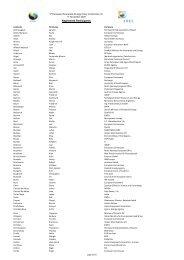
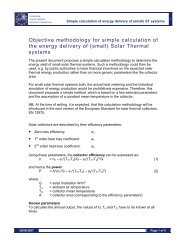


![Energy [R]evolution - Greenpeace](https://img.yumpu.com/47174859/1/184x260/energy-revolution-greenpeace.jpg?quality=85)
